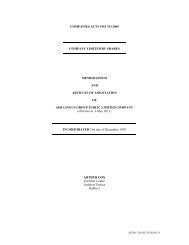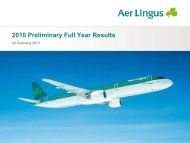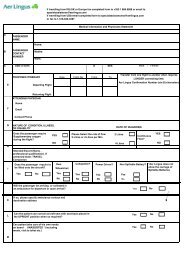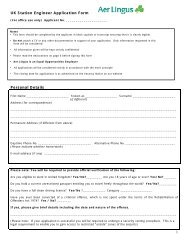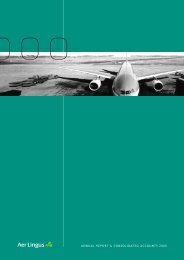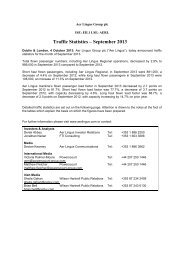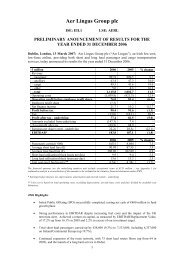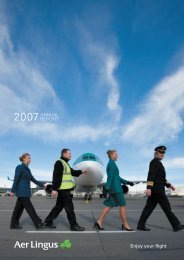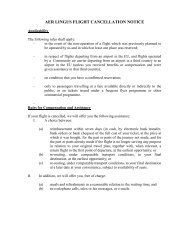Annual Report 1999 in PDF - Aer Lingus
Annual Report 1999 in PDF - Aer Lingus
Annual Report 1999 in PDF - Aer Lingus
- No tags were found...
You also want an ePaper? Increase the reach of your titles
YUMPU automatically turns print PDFs into web optimized ePapers that Google loves.
AER LINGUS GROUP PLCJKLMLeasesAssets held under f<strong>in</strong>ance leases, which transfer substantially all the risks and rewards of ownership to the Group, are<strong>in</strong>itially recorded at their fair value at the <strong>in</strong>ception of the lease. The equivalent liability, categorised as appropriate, is<strong>in</strong>cluded under "Creditors due with<strong>in</strong> and after one year". Assets are depreciated over the lease term or their usefuleconomic lives, as appropriate. F<strong>in</strong>ance lease charges are allocated over the periods of the leases to produce constantrates of return on the outstand<strong>in</strong>g balances.Rentals under operat<strong>in</strong>g leases are charged on a straight l<strong>in</strong>e basis over the lease term.Aircraft Ma<strong>in</strong>tenanceProvision is made, on a time apportioned basis, for aircraft ma<strong>in</strong>tenance costs to be <strong>in</strong>curred <strong>in</strong> connection with majorairframe and eng<strong>in</strong>e overhauls on leased aircraft where the lease terms impose obligations on the lessee to have theseoverhauls carried out. The actual costs of the overhauls are charged aga<strong>in</strong>st the provision.As <strong>in</strong>dicated <strong>in</strong> account<strong>in</strong>g policy F, the costs of major ma<strong>in</strong>frame and eng<strong>in</strong>e overhauls <strong>in</strong> respect of owned aircraft arecapitalised as part of the cost of the related aircraft. This represents a change <strong>in</strong> account<strong>in</strong>g policy aris<strong>in</strong>g from theadoption of FRS12 (Provisions, cont<strong>in</strong>gent liabilities and cont<strong>in</strong>gent ga<strong>in</strong>s), as previously provision was made on a timeapportioned basis for aircraft ma<strong>in</strong>tenance costs <strong>in</strong> respect of all aircraft. The effect of the change <strong>in</strong> policy is notmaterial.Foreign CurrencyIn the accounts of <strong>in</strong>dividual companies, transactions denom<strong>in</strong>ated <strong>in</strong> foreign currencies are recorded <strong>in</strong> the local currencyat actual exchange rates at the date of the transaction or, where appropriate, at the rates of exchange <strong>in</strong> related forwardexchange contracts. Monetary assets and liabilities denom<strong>in</strong>ated <strong>in</strong> foreign currencies are translated us<strong>in</strong>g the rates ofexchange prevail<strong>in</strong>g at the balance sheet date or, where appropriate, the rates of exchange <strong>in</strong> related forward exchangecontracts.Ga<strong>in</strong>s and losses aris<strong>in</strong>g from foreign currency translations and on settlement of amounts receivable and payable <strong>in</strong>foreign currency are dealt with <strong>in</strong> the profit and loss account.In prior years, changes <strong>in</strong> the report<strong>in</strong>g currency value of outstand<strong>in</strong>g foreign currency liabilities which f<strong>in</strong>anced aircraftwere offset as reserve movements to the extent of the exchange differences aris<strong>in</strong>g on the translation of related aircraft.In the light of movements <strong>in</strong> exchange rates the policy has been changed with all such exchange differences now dealtwith <strong>in</strong> the profit and loss account. This policy is considered more appropriate given developments <strong>in</strong> <strong>in</strong>ternationalf<strong>in</strong>ancial markets and as a result the carry<strong>in</strong>g value of aircraft <strong>in</strong> the balance sheet is not exposed to exchange ratemovements. The effect of this change <strong>in</strong> policy is set out <strong>in</strong> Note 1.For the purposes of consolidation of subsidiaries and application of the equity method of account<strong>in</strong>g <strong>in</strong> respect ofassociated undertak<strong>in</strong>gs, the clos<strong>in</strong>g rate/net <strong>in</strong>vestment method is used, under which translation ga<strong>in</strong>s or losses areshown as movements on reserves. Profit and loss accounts of overseas subsidiaries are translated at average exchangerates.Treasury InstrumentsThe Group enters <strong>in</strong>to transactions <strong>in</strong> the normal course of bus<strong>in</strong>ess us<strong>in</strong>g a variety of treasury <strong>in</strong>struments <strong>in</strong> order tohedge aga<strong>in</strong>st exposures to fluctuat<strong>in</strong>g exchange rates, <strong>in</strong>terest rates and fuel costs. These transactions are accounted for<strong>in</strong> accordance with their economic substance.The pr<strong>in</strong>cipal transactions are forward contracts and currency swaps entered <strong>in</strong>to <strong>in</strong> order to change the currencyexposure of foreign currency debt positions. Such forward contracts and swaps are revalued at clos<strong>in</strong>g spot rates ofexchange and the result<strong>in</strong>g ga<strong>in</strong>s and losses are accounted for on a consistent basis with ga<strong>in</strong>s and losses on theretranslation of the related debt (Account<strong>in</strong>g Policy L). The <strong>in</strong>terest effect of these transactions is accounted for evenlyover the duration of the contracts.Forward contracts and related <strong>in</strong>struments designated to hedge future transactions, such as foreign currency expenditure,are disclosed <strong>in</strong> the accounts as commitments and are accounted for on a consistent basis with the related transactions.31



